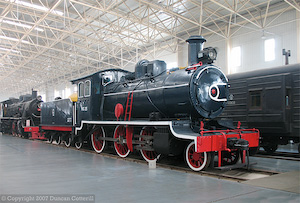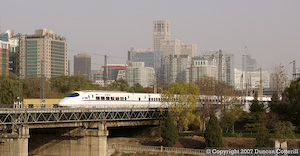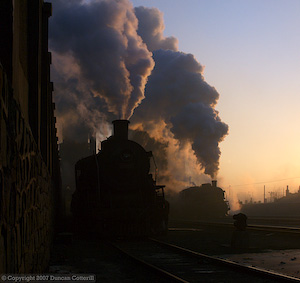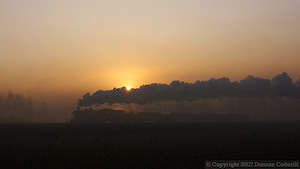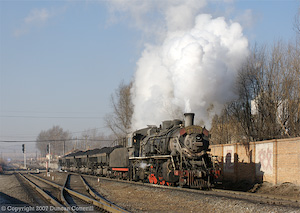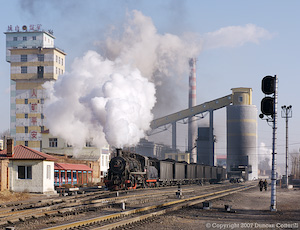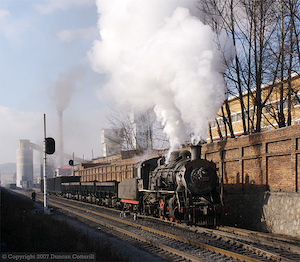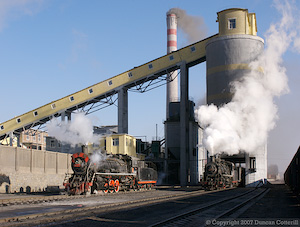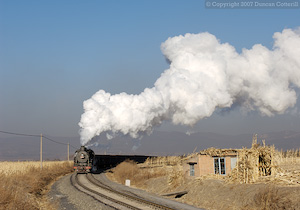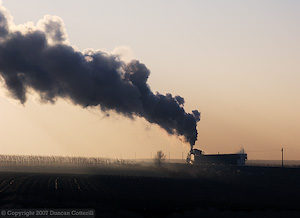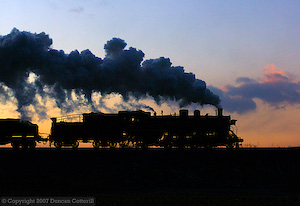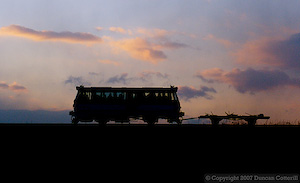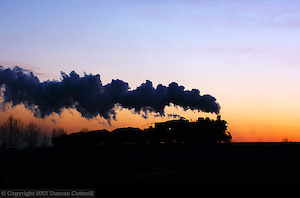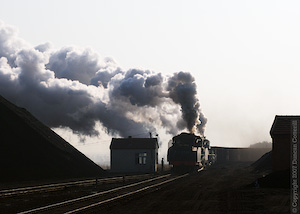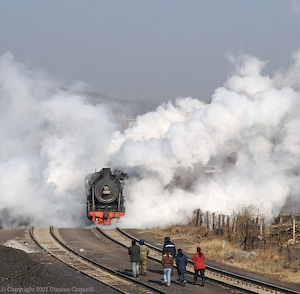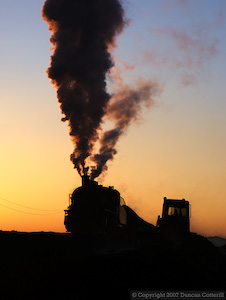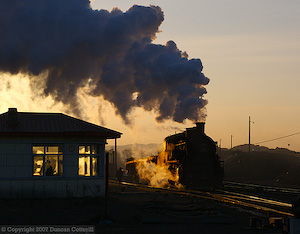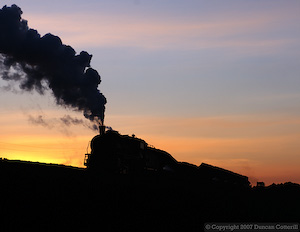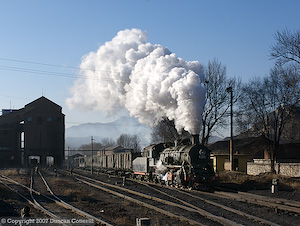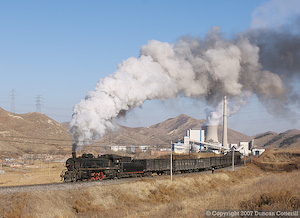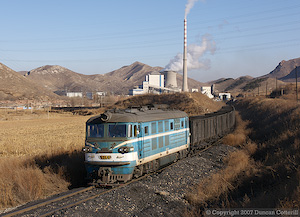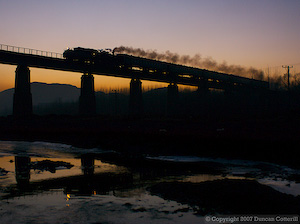Industrial Steam Decline
25 November - 11 December 2007
Report by Duncan Cotterill
Introduction
This trip turned out very differently to the one we planned. The idea had been to get some shots of Huanan in the snow and have another go at Huludao before the diesels arrived. As we were in the area, it seemed sensible to spend a few days in Jixi as well. In the event, there was no snow and Huanan wasn’t running any trains. Huludao had a different problem in the shape of two brand new DF10D diesels that had arrived a few days before our visit and taken over all the line work. Fortunately JIxi didn't disappoint and we ended up spending much longer there than intended. Nanpiao proved to be an acceptable alternative to Huludao.
I travelled with Peter Breeze and our favourite guide, Sun Xiaolan, who made all the arrangements.
Beijing Railway Museum
(25 Nov 2007)After meeting up at Beijing airport, we visited the Railway Museum where a few new exhibits had been added to the collection. Most notable was an elegant 2-6-0 of distinctly British appearance numbered MG 35. DFH3 0009 had joined the ranks of the preserved diesels and, surprisingly, Burmese ST1 class 2-6-4 tank no. 759 was lurking among the meter gauge Chinese locos, looking a bit out of place.
Beijing Main Station
(25 Nov 2007)An afternoon session at the Dongnan Jiaolou tower near Beijing main station produced 17 workings and 9 different classes in an hour and 15 minutes. The undoubted highlight was the appearance of BJ 3028 on train 6451 to Yangcun on the line to Tianjin. High speed CRH2 (Kawasaki/Sifang) electric units were seen on trains D36 and D37 to/from Jinan and trains D541 and D542 to/from Tianjin while a rather older DFH5 0368 was seen working ECS into the station. Other classes observed were DF4B, DF4C, DF4D, DF7C, DF11 and SS9G.
Beijing to Jixi
(25-26 Nov 2007)In previous years we had been able to fly to Harbin then take an overnight train all the way to Jixi but this year there were no flights to Harbin at suitable times. We ended up taking the 21:00 flight to Mudanjiang on the evening of 25 November, staying overnight then continuing to Jixi by road the following morning.
Jixi Mining Railway
(26 Nov – 06 Dec 2007)Despite the recent introduction of diesels on the Hengshan system, this is still a fabulous place to photograph steam locomotives. The other four systems remain 100% steam worked and the variety of quality shots and excellent locations available is without equal in China today. We stayed at Jixi much longer than planned due to the problems at Huanan (noted elsewhere) but still found plenty to keep us productively occupied.
Lishu System
Lishu is the most scenic of the Jixi systems but also one of the most difficult to photograph. The vast majority of uphill working is tender first with only the climb from the junction at Taiping to the reversal just before Qikeng being chimney first. Traffic levels are erratic and workings are difficult to predict.
The line to Qikeng mine was quiet with only one train on most days we were there. The washery at Xinfen was also taking coal brought by road from other mines in the area, so the output was fairly high in spite of the dearth of coal coming from Qikeng. Pinggang mine also seemed busy and was served by at least two trips a day. However, these trains were tender first uphill so not a great photographic prospect. Between them, Pinggang and Xinfen were generating enough coal to require at least two trips to the CNR interchange each day.
The locomotive situation remained unchanged with all three locos seen in action, although only two were present on two of the three days we visited.
Working Locos : SY 0477, 0951, 1118
Hengshan System
We didn’t spend long on the Hengshan system as it now has four diesels and limited steam working, however we did pass en-route to and from Lishu on several occasions. On 1 December there were four SYs in use in addition to the diesels, SY 0804 was at Xinhengshan early in the morning and later SY 0341 and 1095 were seen working the mine at Xiaohengshan. SY 0898 was at Erkuang as usual. It appeared that four diesels had only replaced 3 SYs!
Three of the diesels were seen at Xinhengshan one morning but not close enough to be identified.
Working Locos : SY 0341, 0804, 0898, 1095
Donghai System
Two visits were made to Donghaikuang. The mine appeared to produce one, possibly two trainloads of coal each day. Although only one engine was required to work most trains downhill to the CNR junction, some of the shunts required both the locos stationed here. We followed the line around the corner from the main loader for a few hundred metres to a point where coal brought in by lorries was being loaded into a rake of 20 wagons. Both SYs coupled up and had to work hard to drag the loads back up to the mine. The departure for CNR with a single engine an hour later was nothing like as spectacular.
It was a surprise to see SY 0746 here as it was always a Hengshan loco. It may have been covering for SY 1545, which wasn’t seen and may have been in works for an overhaul.
Working Locos : SY 0639, SY 0746
Chengzihe System
Chengzihe remains the best of the five railways at Jixi with plenty of activity and a wide variety of good locations. Initially, the area around Dongchang and Beichang was incredibly busy, with spoil and hopper trains operating at hourly intervals all day long. By the end of our stay things had quietened down a bit and the gaps between trains were considerably longer.
Traffic to and from the two eastern pits at Zhengyang and Xinghua was steady and on most days an empty spoil train and an empty coal train would go up the bank to Xinghua during the morning. The spoil train remained up there all day and the coal would return at sometime in the afternoon. Another feature of most mornings was the parking of a long rake of empties on the main line parallel to the silos at Dongchang, making the classic “against the light” shots at sunrise almost impossible.
Curiously, the loco on the hoppers was often tender first overnight but invariably chimney first during the day. We saw several instances of the tender first workings losing adhesion on the climb and one train had to set right back to Dongchang and have another run at the bank. As would be expected, all of the chimney first workings made the top of the bank without too much difficulty. Locos on the coal trains serving Zhengyang and Xinghua could face in either direction but most locos continued to face west.
The method of working the SYs while loading the hopper trains was interesting. The requirement was to move the train slowly but steadily under the silos while coal was dropped in from above. I had imagined that this would be done with the regulator cracked open but this was not the case. The driver would open the regulator quite a way then close it immediately. Every few seconds he would repeat this open and close routine until the train was loaded. Instead of moving in short jerky motions, as might be expected, the result was a really smooth, steady crawl.
SY 1340 and 1369, both formerly at Hengshan, have joined the Chengzihe fleet and we concluded after a few days that all the older locos had probably been withdrawn. Then SY 0863 appeared, followed by ex-works SY 0590. SY 0733 was the only loco we expected to see but didn’t.
Working Locos : SY 0590, 0863, 1058, 1340, 1344, 1351, 1369, 1437, 1544
Didao System
This compact system has plenty to offer the photographer with good industrial locations and hard working SYs. Activity can be a bit sporadic, one minute you’re trying to compose a shot as three locos move in different directions through your viewfinder and five minutes later it’s as dead as a dodo. However it’s usually worth hanging on for the next busy spell. We were lucky to get a load of tippers going up the unloading ramp at the south end of the washery yard at sunrise one morning and ever luckier to return a few days later to see the spectacle repeated in similarly spectacular lighting conditions.
The yard at Hebei washery has been fenced off but there is a gate in the fence and the locals continue to cross the line at this point. We gained access this way as well and, apart from being approached once by a mine policeman who told us to take care because of moving trains, we were allowed to photograph unimpeded.
Didao’s loco fleet was largely unchanged from recent visits. SY 1018 was the only unexpected sighting and SY 0407 the only loco we might have expected to see but didn’t. SY 1018 has been reported at Chengzihe, Hengshan and now Didao and it seems to be the floating spare. We thought SY 0407 had probably been withdrawn although Dave Fielding saw it working in late November.
Working Locos : SY 0950, 1018, 1205, 1213, 1446
CNR Jixi Area
(26 Nov – 06 Dec 2007)Freight traffic on the line to Linkou was heavy and mainly worked by Mudanjiang based DF8s. Many trains were hauled by pairs of DF8s and some DF8 + DF4B combinations were also seen. Passenger trains were no longer the sole preserve of Sankeshu’s class DF4DK locos west of Jixi. On 27 November, trains N67 from Mudanjiang to Jixi and N68 return were worked by DF4D 3235 (SKS) but N54/55 from Qiqihaer to Jixi had DF4D 0503 (SKS) and N78 from Dongfanghong to Mudanjiang was hauled by DF4 1062 (MDJ). Very little traffic was seen on the line south of Jixi in spite of spending a considerable time at Lishu. DF4B continue to work freights here. At Hengshan, DF5 2056 was the yard pilot and a pair of DF4s were seen waiting to leave with a coal train at midday on 1 Dec.
Depots : SKS = Sankeshu (Harbin), MDJ = Mudanjiang
Huanan Forestry Railway
(28 Nov 2007)We travelled from Jixi to Huanan by road on the evening of 27 November. A drive out to Xiahua early on 28 Nov found no sign of traffic. The station staff at Xiahua told us that no trains had run since 25 November and the log book confirmed this. They didn’t know when traffic would restart. Back at the offices at Huanan we were told that there was a problem obtaining fuel supplies for the unloading equipment and once that had been resolved then trains would start running again. However, as this was unlikely to happen in the next day or two, we returned to Jixi. Phone calls over the next few days revealed that no fuel could be found and the line might stay closed for a considerable time, possibly until late December. The diesel fuel shortage appeared to be widespread. We saw lorries and buses being turned away from petrol stations in Jixi that had no diesel fuel. There were also pictures of long queues at petrol stations around the country on national TV.
Jixi to Huludao
(06 – 07 Dec 2007)On 6 December we left Jixi and travelled to Mudanjiang by road, continuing on train 1452/1449 overnight to Huludao. DF4D 3020 (SKS) was in charge for the first leg and an SS9G was on the front when we arrived at Huludao Bei the following morning.
Huludao Limestone Railway
(07 Dec 2007)We had been warned of the arrival of two diesels by one of Xiaolan’s colleagues who was escorting a Japanese group a few days earlier. The last JS in service had its fire dropped two days before we arrived but we decided to check the shed out just in case there had been a change of heart. When we arrived at the depot DF10D 0159 was idling outside the shed. SY 1415 was in steam but a second SY was dumped. All the JS were said to be inside the shed, out of use. After ascertaining this, we decided to go to Nanpiao instead.
Working Locos : SY 1415, DF10D 0159
Nanpiao Mining Railway
(07-10 Dec 2007)The Nanpiao system has plenty of photographic potential but little of it is realisable due to the forests of poles and spider’s web of wires that accompany the railway wherever it goes. The unchecked undergrowth along the tracksides doesn’t help much either. The presence of one BJ made things difficult enough during my last visit in early 2004 so the acquisition of two more just about killed off any interest I had in this system.
In reality, the line turned out to be better than expected as the diesel and steam workings could often be predicted in good time. The afternoon passengers were a good example of this with the locos often waiting on their trains over an hour before departure time. The traffic pattern has changed considerably since early 2004 with most coal now going to the new power station in internal wooden bodied wagons. It was late on the our third day before we saw the first CNR wagons on the system.
There wasn’t a strict pattern of operation but most of the time the east end of the system seemed to be operated into two sections, with one loco shuttling between Zaojiatun and the power station and other locos working north of Zaojiatun. The spoil workings from Zaojiatun to the nearby tip appeared to have stopped running. Although the rails to the tip were still in situ, they were fairly rusty.
Seeing a steam hauled train of loaded internal wagons leaving Zaojiatun for Xiamiaozi was a good indication that there would be a steam working to the power station before too long. It didn’t always work as the train could be re-engined at Xiamiaozi but it was a pretty reliable indicator. Trains to the power station were worth getting as they involved chimney first working on an uphill loaded train and you could be sure that the empties would return after 20-30 minutes, also chimney first and uphill as far as Hongshila. There seemed to be trains to the power station every 3 to 4 hours on most days.
The BJs were an annoyance but there didn’t seem to be any attempt to maximise their utilisation. The SYs still handled at least half the traffic including at least one of the passengers every morning and evening. The second train was often diesel but not always. If the diesel worked to Sanjiazi in the morning it would usually work the Linhe in the afternoon or vice-versa.
SY 0973 appeared to be restricted to shunts around the station at Xiamiaozi and was in poor condition. The other SYs seemed to be mechanically sound.
We stayed at the Xinghe Hotel between Xiamiaozi and Shagoutun, on the opposite side of the river to the line, and found the standard of accommodation to be more than adequate. The hotel can be easily identified by the stone elephants on either side of the front door.
Working Locos : SY 0366, 0973, 1299, 1478, BJ 3132, 3241, 3248
Overhaul : SY 1092
Stored ex-works : SY 0754
Nanpiao CNR
(07-10 Dec 2007)We didn’t see much activity on the CNR line to Nanpiao. The early morning passenger from Jinzhou was worked by a very smart DF4C on the two occasions we saw it, DF4 4461 one day and DF4 4465 the next. The only freight we saw was a long train of empty coal wagons worked in by decorated DF4 9007 on 10 Dec.
Nanpiao to Beijing
(11 Dec 2007)We had originally planned to take train 1468 from Huludao to Beijing but switched to train D24 due to the availability of reserved seats from Huludao. 1468 comes from Jagedaqi in the far north and there was no certainty that there would be any sleepers available by the time it arrived at Huludao. Standing in hard seat for the 6 hr 15 min journey was not an enticing prospect. D24 was a newly introduced high-speed day train from Changchun to Beijing and covered the 460 km in 2 hr 45 min, an average of almost exactly 100 mph or 160km/h. The train was formed of a 7-car class CRH5 EMU (Alstom) with first and second class seats rather than hard and soft class. We travelled second class and didn’t find it too cramped despite the 5-a-side seating. The method of loading passengers was quite different to the usual practice of waiting until the train arrives then letting loose the scrum. Passengers were allowed onto the platform around 15 minutes before arrival and then marshalled by staff to ensure they were in the right position to board their coach before the train arrived. The train stopped, doors opened, about 100 people piled on and we were off in barely two minutes. It was all very impressive, as was the journey to Beijing. Once away from Huludao we were rapidly up to a blistering speed, well in excess of 200 km/h by my estimation. I tried to calculate our speed from the km posts but we were going so fast it was impossible to tell the km posts from the other trackside posts. At up to 200 km/h, I don’t usually have this problem. Arrival at Beijing was 2 minutes ahead of right time at 13:27.
Sightings en-route were difficult but there were loads of coal trains in the Qinhuangdao area, all but one hauled by SS4G twin units, often in multiple. Even at our great speed it took quite a long time to overtake a 200 wagon mega-train powered by four twin units, one at the front, two in the middle and one at the rear. One coal train was seen in the distance with what appeared to be a Bombardier TRAXX or Siemens EuroSprinter twin unit finished in a blue/silver livery.
There were a lot of DF8B in the Shanhaiguan / Qinhuangdao area but west of there most freight was electrically hauled, mostly by SS1s but a few SS3 or SS3B were also seen. A couple of the original DF7s were seen at Beijing Dong and a single BJ and a twin unit were on shed at Beijing passenger depot. A couple of the big Henschel hydraulics were also outside the shed but with their windows plated over.
Arriving in Beijing allowed time for a visit to the Echo modelshop before demolishing a duck or two and enjoying a bier at the Paulaner Brauhaus. We got to the modelshop by taking airport bus No 5 to its terminus then walking east half a block and south a block and a half. The selection of models on sale was disappointing but I did manage to get six C64s and a caboose.
Conclusions
In spite of the disappointments of failing to get any action at Huanan (again) and missing Huludao by a few days, it was still a good trip. The weather was relatively kind with good light on most days but no snow until the last day at Nanpiao.
The thought of finding enough to fill ten days at Jixi was a bit daunting but the lack of time pressure did mean that we could try shots we might not have bothered with on a shorter visit. I was more than satisfied with the results.
Jixi is probably the best of the remaining industrial steam locations in China. It may not be as spectacular as Zhalainuoer or Sandaoling but it has a far greater variety of locations. How long it will remain good is questionable. More diesels are expected during 2008.
After two trips to Nanpiao in late 2003 and early 2004, I had no intention of ever going back. It was difficult enough with one BJ working and with three BJs, there shouldn't have been much for the remaining SYs to do. Fortunately the BJs weren't worked intensively and there was still plenty of steam action. The line appeared to be busier than on our earlier visits, probably due to the power station being fully operational. Fortunately, it was usually possible to work out which trains would be steam early enough to get into position for a shot.
Our trip back from Huludao to Beijing was a real eye-opener. China has entered the era of high-speed rail and appears to be making a success of it. The results so far are very impressive. As has happened in so many countries before, travel becomes so much easier and quicker just too late for the steam fan.
There was some speculation in the autumn that standards of CNR loco cleanliness had fallen and brass embellishments had been removed from decorated locos. We saw no evidence of this and can report seeing a number of decorated locos and plenty of clean ones. Decorated engines were seen around JIxi, Nanpiao and on the way back to Beijing.
Steam isn't quite finished yet. Although it's getting more and more difficult to find good steam locations, there are still around half-a-dozen top quality steam centres left with another half dozen worth visiting if you're in the area. If you want to see real working steam, go soon. There's still enough good stuff to see but it won't last for ever.
